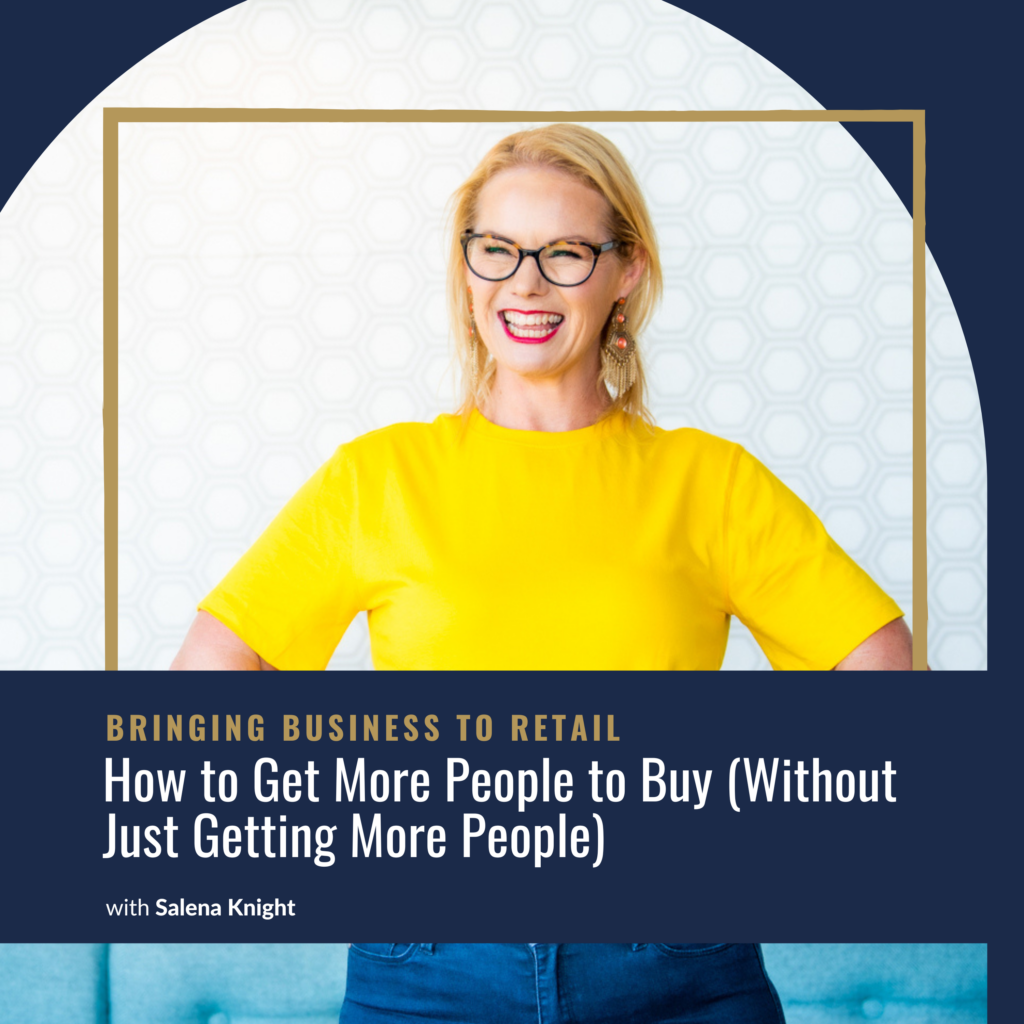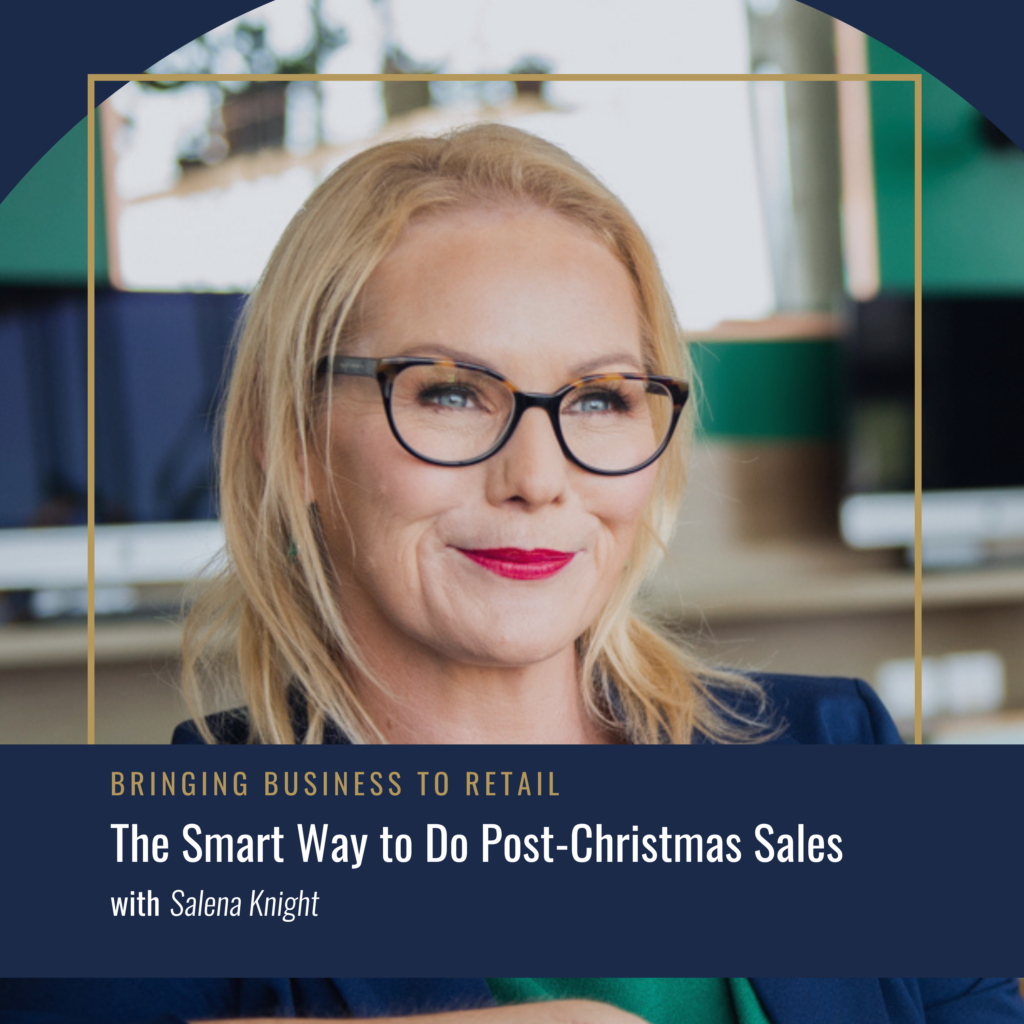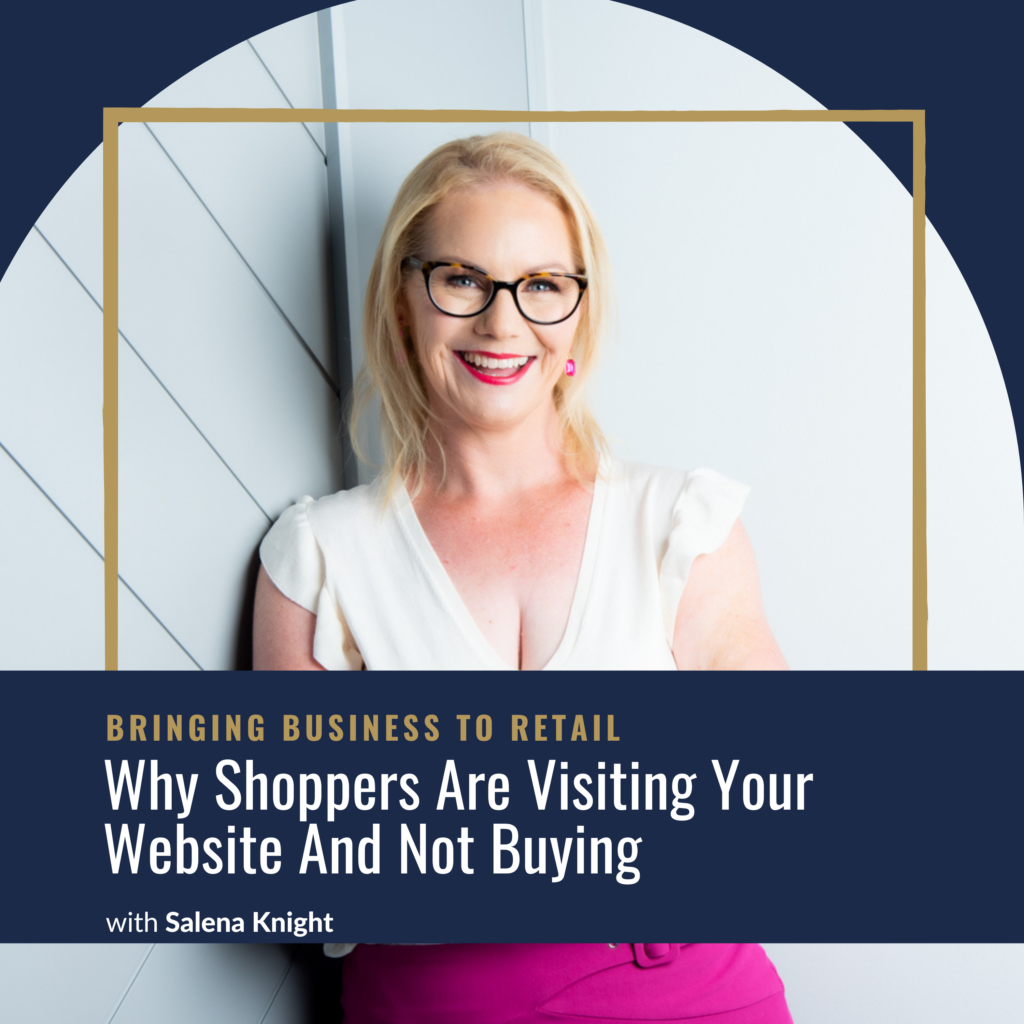
SHOW NOTES
Three times in one week I tried to buy something—and didn’t. Not because I changed my mind, but because the buying experience got in the way. A login prompt here, a slow site there, and suddenly I’m distracted and the sale is lost. Sound familiar?
In this episode, I’m diving deep into micro-moments—those fleeting, high-intent seconds where your customer is ready to buy right now, usually on their phone. And if your mobile experience isn’t fast, seamless, and friction-free, you’re losing revenue. Daily.
We’ll explore:
- What micro-moments are (and how they’ve changed how people shop)
- Why 60 seconds and 3 taps is your new sales window
- The mobile-first design mindset that turns browsers into buyers
- How to optimize your store’s navigation, search, and checkout for thumb-tapping, distracted shoppers
- Real-world strategies to win sales directly from TikTok, Instagram, and mobile search
- The psychology behind impulse decisions—and how to make your store the easiest “yes” they’ll say all day
By the end of this episode, you’ll know exactly how to audit and optimize your buying experience so you can stop losing sales in those critical, conversion-rich micro-moments.
Here’s to making every second (and every swipe) count.
Sal
LISTEN NOW on The Bringing Business To Retail Podcast
As I record this three times, I've tried to buy something and not finalize my purchase. The first was when I was in a department store and I found a pair of pants that I wanted to buy, but they didn't have my size in stock, so I thought I'll just grab them online rather than having to wait and come back.
So I was walking through the mall. I was on my phone. I found the pants, I added them to cart, but I hadn't shopped with this store before. So I had to create an account and I had to add all of my details in, and then a text message from my husband came through asking me to get some dog food while I was at the shops.
Now, I still haven't bought those pans, even though I really, really want them. The second time I was on the ferry into the city and I was trying to book accommodation for my upcoming trip to San Diego, but the property wasn't on Airbnb, which is where I have an account. It was on another site that I've never used before, and in this instance I can totally appreciate that to sign up to one of these kind of Airbnb type sites.
They need to verify who you were, but I couldn't even create a simple account to wish, list the property and then come back later and fill in my details. Meanwhile, the ferry had docked and I had to get to my appointment. Guess what? I never booked that accommodation. The third time was when I was out with a friend.
She was wearing these really cool red pair of trousers. Remember, I'm searching for trousers, and even though I never got to buy them, when I saw her red trousers, it reminded me that I really wanted these green wide Legg pants. So when my friend went to the bar to order cocktails, I whipped out my phone to search for the pair of green wide Legg pants that I wanted to buy.
I hadn't found them by the time that she came back with our cocktails and we were there to catch up, not to scroll on our phones. So I put my phone away. Still no green wide leg trousers. Each one of those scenarios are what I call micro moments, and they're a really simple way to make or to lose a sale.
So what the heck are micro moments? Well, they're those split second instances when somebody grabs their phone searches for something that they need or they want or are curious about. And here's the kicker. These moments are when buying decisions are made or lost. We're talking about capturing customers in those exact seconds when they're ready to buy.
The reality is these days your customers are not sitting at their desks thoughtfully browsing your website anymore, okay? They might be doing that in their lunch breaks, but they're not doing that for the majority of the time. They're standing in line at the grocery store, Googling vest, running shoes for kids, or they're lying in bed at 11:00 PM searching for birthday gifts for teenager daughter.
These are micro moments, and if you are not optimizing your sales process for them, well, you're losing money every single day. Google identifies four different types of micro moments. The I want to know, I want to go, I want to do, I. And I want to buy, so I want to know, go do or buy. Today we're focusing on that last one, those precious, I want to buy moments when someone has their credit card ready, when their buying intent is high and they just need to find the right retailer to take their money.
Hey there, if we haven't met before, thank you so much for joining me here on the Bringing Business to Retail podcast. I'm Selena Knight, and I create solutions that make money for retail and e-commerce stores. So grab your phone because we are going to be talking a lot about mobile today. Let's dive into how you can capture these micro moments and turn them into sales.
All righty. Let's start by really understanding what we're dealing with here. A micro moment isn't just someone quickly looking at their phone. It's a behavior shift that has fundamentally changed how people shop. Think about your own behavior. When was the last time that you had a question or a sudden urge to buy something as you, and you actually waited until you got home to your computer?
Well, if you're like me, as long as you're not driving, no, you pull out your phone immediately. That is a micro moment. It's the standing in the grocery line. It's watching your kids play soccer and remembering that you need to do something or you need to buy something. Here's what the research tells us.
Mobile commerce now accounts for nearly 60% of all e-commerce sales. More than half of e-commerce sales are made on a mobile device globally, and over 70% of internet traffic comes from a mobile device. This means the majority of your customers are shopping on their phones often while they're out and about.
They're multitasking or they're standing even in a physical store deciding what to buy. But here's where it gets really interesting from a psychology perspective, I. There's something called intent compression that happens during these micro moments. Traditional shopping used to involve a very long consideration phase, so maybe somebody would think about buying new workout clothes for weeks.
They would research different brands. They would compare prices. They would read reviews, but now in micro moments, that entire process gets compressed into minutes or even seconds. Someone sees their friends on an Instagram story at the gym and thinks, oh, they're cute. I need new leggings, and immediately searches best yoga pants and buys within five minutes.
The gap between wanting something and purchasing something has virtually disappeared. This creates what psychologists call high intent, low friction scenarios. The customer's intent is to buy is at their peak, but their tolerance for friction, for stopping them to getting to the objective, which is buying the thing.
Whether that is slow loading pages, complicated navigation, lengthy checkout processes, that is at its lowest, they will not stand for friction. There is also the immediate gratification bias at play. When we want something right now, we will often pay more, or we choose convenience over the best deal, huh?
Sometimes the cheapest isn't always what people are looking for. That's why Amazon Prime works so well, and it's why optimizing for micro moments can actually increase your average order value, not just your conversion rate. Now let's talk about the mobile first mindset, because this is crucial. Mobile first doesn't just mean that your website works on a phone.
It means designing your entire experience. Remember, more than half of your sales online are going to come from a mobile device, so it means designing the entire mobile experience for someone who is distracted, who has limited time, who is probably using one thumb to navigate while they're doing something else.
Psychology here is fascinating. Mobile users exhibit what researchers call selective attention. They're scanning, they're not reading. They're making split second decisions based on visual cues, social proof, and gut feelings rather than detailed analysis. Remember, once upon a time, we used to do a lot of research and it took a lot of time to make that decision to purchase.
Now people are not even reading product descriptions. They're literally looking at pictures. Buying off gut feel and social proof eye tracking studies show that mobile users spend an average of 15 seconds deciding to stay, whether to stay on a website or to leave just 15 seconds. That is barely enough, at enough time to read your headline or to read your banner, let alone browse full product catalog.
And this is why traditional retail websites fail in micro moments. 'cause they are designed for the old shopping behavior, the browsing, comparing, thinking you're over. But micro moment shoppers need instant answers. They need instant access and they want instant purchasing. So there's also this other thing called micro stress that happens during these moments.
Someone is searching on their phone while walking, while on a work break, or while their kids are demanding attention, they're experiencing low level stress. So your website needs to reduce that stress, not add to it. I was cooking dinner the other night and the handles on my garlic press cracked, and in that instant I told Alexa to add a garlic press to my shopping list.
Now, normally I would just grab my phone out, but I was making meatballs and my hands were all icky. But that is a micro moment. That instant when a customer realizes that they need a better can opener or a garlic press in the middle of making dinner. They search on their phone and they purchase optimizing for these micro moments, streamlining navigation, OneTap, purchasing, immediate product recommendations.
If you do that, you will find your mobile conversion rate increases dramatically. The key insight here is that micro moments aren't just smaller versions of desktop shopping sessions. They're entirely different behaviors that require entirely different strategies. I know just when you thought that you were on top of this, all Sal comes along and says, you need to optimize for micro moments because your customers in these moments are asking, can you solve my problem right now with minimal effort in a way that feels like I can trust that I'm going to get what I want?
And if the answer is yes, they're going to buy. If there is any friction, any confusion, any delay, they're gone probably to a competitor. So the question becomes, how do you optimize every single touch point for those split second decisions? How do you build that trust instantly? How do you make purchasing effortless?
Well, that is what we're diving into next. So let's get tactical about capturing those. I want to buy micro moments. This is where the magic happens when somebody has their credit card mentally ready, and they just need you to make it easy for them to give you their money. First, let's talk about search optimization.
Now, this is not the traditional SEO that you might be thinking of. We're talking about micro moment, SEO, optimizing for those specific. Urgent searches that people do when they're ready to buy. Think about how you, or take note next time you are in the grocery store. What are you typing in? So traditional keywords, research focuses on really high volume terms, like maybe running shoes or organic skincare, but micro moment keywords are very, very different, and they're often much longer and more specific.
And they include urgent language like. Running shoes for flat feet. Buy online or acne treatment that works overnight or last minute birthday gift delivery today. The other thing is running shoes near me. So near me is a very, very big search term. So these searches probably have lower volume overall. So running shoes near me probably has a much lower volume than, uh, running shoes, but it is incredibly high intent.
Someone searching where to buy protein powder near me open. Now they're not just browsing, they're literally looking to buy. And here's the beautiful part. Those high intent keywords are often less competitive because most retailers are still chasing their high volume, low intent terms. But here is where mobile optimization becomes crucial, because even if you rank number one for those terms, you're still going to lose the sale if your mobile experience isn't flawless.
So let's talk about mobile page speed first, because this is make or break for micro moments. Google's research shows that 53%, so more than half of mobile users abandon a site that takes longer than three seconds to load these days. Three seconds is an eternity in the internet, but in a micro moment, that tolerance gets even lower.
We're talking about one second maximum, huh? Every fraction of a second matters. Amazon actually found that every 100th of a millisecond delay in load time decreased sales by 1%. That is huge for a micro moment shopper who is already stressed, already impatient, already distracted. A slow loading page is an instant deal breaker.
So the technical stuff matters here. Optimizing your images using compression, minimizing any redirects, leveraging browser caching, but more importantly, prioritize what loads first. If a video takes ages to load, don't put that first. Think about your product images, your price, and the buy now button.
Those should appear instantly, even if other elements are going to take a little bit longer. So let's talk about mobile navigation, because this is where I have to say, a lot of retailers lose out on my money. Desktop navigation is different. You are thinking differently when you are shopping on your laptop than when you are shopping on your phone, and I don't think desktop navigation works in the same way as when you are thinking about buying on a mobile.
And just take note. Next time you go to buy something on a mobile device, think about what you are searching for, the kinds of words that you're searching. Go to a big brand site and just pick out, I want pink running shoes, and see what happens. Now that's gonna be very different to how you shop on a desktop.
So the dropdown menus, the sidebar filters, all those sorts of things that are great on a laptop or on a computer, they become friction nightmares on a phone. Micro moment. Shoppers need what I call fast path navigation. They should be able to get from your homepage or wherever they land, to purchasing a product within three taps maximum.
This means a really easy search functionality, clear category, buttons that are sized for people's thumbs, my friend and smart product recommendations I love. Some brands have predictive search function where you start typing in the product and it will come up with a list of the items so you can go, you don't have to click, so you are looking for pink running shoes as you type in pink, RU.
It will come up with pink running shoes and the different individual products as opposed to having click pink running shoes, have the page load, which might be fine on a desktop, and then having to click into each individual product. So if you ever want inspiration here, think about how Apple designs their mobile interfaces.
Everything is thumb friendly. Everything is visually clear, and it requires minimal cognitive load. That is the standard that your mobile site needs to be to get people to buy in these micro moments. That search functionality is absolutely critical for those micro moments. It needs to be if you can, predictive, it needs to be tolerant of typos because we're typing with our thumbs sometimes with one thumb, and we get things wrong, and it has to return results instantly as people type.
So if someone is searching for red dress, they shouldn't have to scroll through 500 products. The most popular, best reviewed, or newest items come first. And here's a game changer. I saw this on a website the other day. Voice search. If you can implement voice search optimization, then you, my friends are so far ahead of other retailers because more and more of these micro moment shopping experiences start with things like, Hey Siri, find your birthday gift for my mom.
Or, okay, Google, where can I buy organic dog food? Voice searches are generally longer and they're more conversational, and I always feel like they're more specific, even though they're conversational because they're longer, they give you more information. So it's time to start optimizing for natural language queries rather than really simple fractured words like pink running shoes.
So maybe you might, you might target something like. Pink running shoes that are orthotic friendly. Oh, can I have those running shoes that are orthotic friendly? I would love to do that. Product pages need to be, so we've gone from mobile site with your product pages that if you completely reimagined for micro moments, so whilst on a desktop you might want really long descriptions.
On a micro moment, you want short descriptions. You want detailed specifications for things that people are searching for, so lead with all of that essential information, product images, price benefits, and social proof. Everything else should be in expandable sections for people who want more details. And that buy now button, it needs to be persistent and prominent.
So what's a persistent buy now button? It means it scrolls as they scroll down the page. So if your buy now button on a mobile device is right at the bottom, then I have to have so many more scrolls to be able to add it to cart. So think about where that button is placed on a mobile device, because if someone scrolls through your product page, if that purchase button, it should really always be visible.
And make it descriptive. You could try, just add to cart, but buy now ships today if that's something that you can offer. Remember, on a mobile micro moment, getting people to commit, buy now ships today, add to cart free two day shipping, whatever it is, that is your value add. So here's where psychology becomes crucial.
Again, micro moment shoppers are making emotional, gut-based decisions. They need instant reassurances that they're making the right choice. So that means making sure that reviews are prominent. Customer photos need to be really accessible. If you have any guarantees, make sure you put those in and your return policy should be visible immediately.
That's probably gonna be one of the highest buttons after shipping that people are going to click on. So one of my retailers that I worked with, a jewelry retailer, they increased their mobile conversion rate by 45% by simply adding in a 30 day free returns badge next to their add to cart button.
Because after they did some research, they found that that was the biggest thing people worried about was, what if I get it home and I don't like it, or I, it doesn't fit? They wanted to know that they can return it. So sticking that in to the mobile site literally nearly doubled their conversion rate.
That tiny little bit of risk reversal was enough to push those micro moment browsers into buyers so that. Other thing is social proof. That is especially powerful in micro moments. Remember, we are looking for reassurance. As a buyer, you want to make sure that the thing you are buying is legit. So 5,000 happy customers or bestseller staff picks recommended by dermatologists.
All of that provides instant credibility and. The other thing that you might like to try out is real time inventory information. So if you only have a few in stock, having messages that say, only three left in stock, or two people bought this in the last hour, that's gonna create that urgency that matches shoppers emotional states.
Now, don't make it up. Don't be fake because fake scarcity will always backfire when customers realize they've been manipulated. And here's something that most retailers miss, even the big brands. Optimize for buy now versus add to cart. Remember, in those micro moments, people often want to complete the entire purchase immediately, not build up a cart for later consideration.
So try it out. What's the difference in your conversion between add to cart and buy now? Maybe buy now significantly increases your conversion rates. The key is to remove every possible point of friction between the customer's impulse to buy and the completion of that purchase. Because every extra tap, every confusing element, everything they have to close down is a moment of doubt and an opportunity for them to abandon the purchase and just move on to something else.
Let's talk about when they finally get to the part where they're going to give you their money checkout. And this is where most micro moment sales are won or lost, just like my green wide Legg trousers and my accommodation, because this is where the friction honestly becomes fatal for your bottom line.
Because the data tells us that the average mobile checkout abandonment rate is 77%. Well, it's not only about 70% on a desktop, so it's another 10% higher on a mobile device because these shoppers have immediate needs. They're buying a gift for tomorrow, they're searching for something for an event this weekend, they're solving an urgent problem.
For me, it was trying to remember to buy the trousers while I could remember to buy the trousers. So let's fix this first, first rule of micro-commitment. Checkout guest checkout should be the default and in the most prominent option. Requiring someone to create an account is just like me and my accommodation.
It is the fastest way to kill a micro moment. Sale People in these urgent buying moments don't wanna think about passwords or fill out their profile information. They just wanna buy and move on with their lives. If you want to capture their information for future marketing, do it after the checkout purchase is complete.
You could offer an incentive to create an account, or you could offer them exclusive offers to create an account. It's much more effective than blocking the sale upfront. And form optimization is critical. Making sure that you have autofill, smart defaults, and what I call progressive disclosure. So instead of filling out a giant form with 15 different fields, just show them one screen at a time, if you can.
Name, shipping, address, payment, and then confirmation. Each step should feel quick and effortless, and please, please make those forms thumb friendly. I cannot tell you how many mobile checkouts I've abandoned altogether because the input fields were too small, too close together. They didn't autofill.
Mobile design practices come first. Large tap. Plenty of spacing, clear labels. And payment friction is the micro moment killer. This is where things like Apple Pay, Google Pay, PayPal Express, and Shop Pay become absolute game changers. Honestly, if you do not have those installed in your website, you are losing money.
One tap payment options, things like Google Pay, apple Pay, or Double Tap. In the case of Apple Pay, they can increase mobile conversion rates by up to 30%. Think about that. 30% more sales just for implementing something like Shop Pay, Google Pay, apple Pay, because it eliminates the pain of entering someone's credit card information on a small screen.
Honestly, I'm gonna say I am almost a 90%. Abandonment rate if they don't have Apple Pay. I don't even, I can't even tell you where my credit card is right now because it is in my phone. I don't have a purse. I don't even have a wallet unless my wallet sits in my travel box. And I only grab it out when I'm going traveling and I need, you know, my physical forms of id.
So if you don't have Apple Pay or Google Pay or Shop Pay, then there's a really good chance that I just won't buy from you. And I'm probably like a lot of the population. So customers who are ready to buy, who have credit card information saved in their phone, all they wanna be able to do is double click their side button or use their fingerprint to complete their purchase.
But if those options aren't available and they have to go and find a credit card, or manually enter 16 digit card numbers and expiration dates and security codes and billing addresses on a tiny keyboard, guess what happens? They abandon the cart, they buy from somebody else who has it set up. And here's what's crazy.
Apple Pay, Google Pay and Shop pay aren't as convenient. They're actually more secure than traditional credit card entry, which means for you, you have a much lower chance of fraud. But here's the key. Make these fast payment options prominent and trustworthy. Don't hide Apple Pay at the bottom of your payment options.
Make it the first choice for customers. Oh, and next after payment becomes shipping and delivery. Now those need special attention for micro moments. These shoppers, generally, they're looking for something to get to them fast. They're buying a gift for tomorrow, or they're buying something for an event this weekend.
They're solving an urgent problem, so lead with your fastest shipping options and be crystal clear about when they're likely to arrive so you could have a checkout order in the next two hours for same day delivery. Or buy now. Pick up in store in 30 minutes. Those can be powerful conversion drivers for micro moment shoppers.
Now, even if they don't choose the fastest option, knowing that it's available builds confidence. I worked with one retailer to implement Uber deliveries. And they found that on Friday afternoons, their sales absolutely skyrocketed once they put in Uber deliveries. And that's because people wanted that product for the weekend.
Alright, let's talk next about social commerce, because this is where micro moments are increasingly happening. People aren't just searching for products, they're discovering them on Instagram, TikTok, Facebook, Pinterest, all of the places, and they want to buy immediately without leaving the platform. So Instagram shopping and TikTok shop, they're perfect Micromoment platforms because they capture people when they're already browsing and they're already in a discovery mindset.
If someone sees a product in an Instagram story, taps the shopping tag, and can complete a purchase without ever living Instagram, that is friction elimination at its finest. But social commerce only works if you optimize for impulse purchasing. Your social commerce product listings need to be visual.
They need to be immediate. They need to be emotion driven. Remember, people aren't always looking for all the specifications. You wanna lead with things like lifestyle images, not technical specifications, show the product being used or worn or enjoyed, not just sitting on a white background. The key with all social commerce is making sure that that platform's natural behavior is integrated into the way people shop.
So Instagram users expect beautiful lifestyle focused content. TikTok users want authentic, relatable product demonstrations. And Pinterest people, well, with anyone on Pinterest, wants aspirational, well styled inspiration. So when you're thinking about your social commerce strategy, think about how it's going to.
Interact with all of the different platforms, whether they discover you through search or social media or word of mouth, the path to purchase should be instant and effortless. Remember, in micro moments, speed and simplicity always wean out over comprehensive information and elaborate experiences, which is the very opposite of how if you've been in business for a while, you've been taught to sell.
Your job is to eliminate every possible reason for someone to second guess or delay their purchasing decision. Alright, let's bring this all together because micro moments are happening right now, and every day, every minute that you are not optimized for them is revenue. Just walking out the door.
Here's what we covered over, we talked about psychology and how micro moments are very high intent, low friction scenarios where customers compress their entire buying journey into minutes or sometimes even seconds. They're not browsing, they're buying and they need you to make it effortless. Secondly, optimize for mobile first.
So this means lightning, fast load times, thumb friendly navigation, prominent search functionality, and product pages designed for split. Second decision making. Remember 15 seconds is all you get to capture and convert a micro moment shopper. And third, eliminate that checkout friction. Guest checkout, social sign on one, tap payments, autofill, everything, clear shipping options.
Every extra step is an opportunity for people to abandon their car. And fourth, embrace social commerce. Meet customers where they're already spending time, Instagram, TikTok, Pinterest, all the places, and make sure that purchasing is possible, if you can, without leaving those platforms. The reality is micro moments aren't the future of retail.
They're happening right now. While you've been listening to this episode, thousands of people have made impulse purchases on their phones. They've bought products that they've discovered on social media, and they've chosen retailers based on who made the buying process the easiest. So here's what I want you to do this week.
Pull out your phone and try to buy something from your own store. Time yourself from search to product completion. How long does it take? How many taps? How many frustrations? If it took more than 60 seconds or required more than five taps. I'm gonna guess you are missing micro moment sales. And then do the same test with your competitors.
Find the gaps. Where can you be faster, smoother, more convenient than they are? I would love to hear about your micro moment optimization wins. Please DM me on Instagram at the selena night and tell me what changes that you've made and how they impact on your mobile conversion rates, because I love celebrating these victories with you.
Thanks for joining me here on the Bringing Business to Retail podcast. Remember, the world is full of micro moments and it is your job to convert your customers. Until next time, I'll see you on the next episode. So that's a wrap. I'd love to hear what insight you've gotten from this episode and how you're going to put it into action.
If you're a social kind of person, follow me at the Selena Knight and make sure to leave a comment and let me know. And if this episode. Made you think a little bit differently or gave you some inspiration, or perhaps gave you the kick that you needed to take action, then please take a couple of minutes to leave me a review on your platform of choice.
Because the more reviews the show gets, the more independent retail and e-commerce stores just like yours that we can help to scale. And when that happens, it's a win for you, a win for your community, and a win for your customers. I'll see you on the next episode.
Share this episode
Watch The Video

Ready For More?
Facebook-f Instagram Linkedin LISTEN NOW SHOW NOTES In today’s episode, I’m diving into one of










